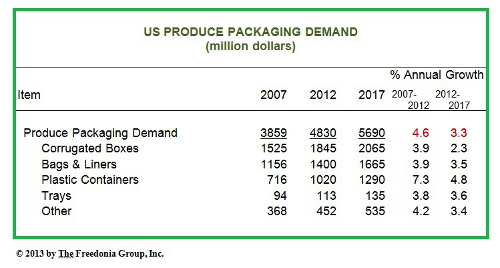
U.S. demand for produce packaging is forecast to increase 3.3 percent per year to $5.7 billion in 2017. Growth will outpace expected expansion in fresh produce production, reflecting the important role of packaging in the protection, safety assurance, and marketing of fresh fruits and vegetables. Also driving gains will be the increasing presence of fresh-cut, ready-to-eat produce. These and other trends are presented in Produce Packaging, a new study from The Freedonia Group, Inc., a Cleveland-based industry market research firm.
Fruit applications are expected to see growth outpacing the overall produce packaging average through 2017. According to analyst Esther Palevsky, this growth will be "supported by population growth, trends toward healthier eating, and the increased availability of ready-to-eat fruit marketed for convenience and as a healthy snack option."
Palevsky continues, "these applications necessitate usage of modified atmosphere packaging for freshness protection." Gains for vegetable applications are expected to slightly trail the average, though advances will be assisted by improved output and ongoing new product introductions of fresh-cut vegetables in nontraditional categories. Salad uses will be constrained by market saturation and price sensitivity among many consumers.
Corrugated boxes, which accounted for 38 percent of demand in 2012, are the leading produce packaging type and are valued for their relatively low cost, light weight, good protective performance, graphics capabilities, and well established recycling infrastructure. Gains will be helped by the increased prevalence of more costly box structures such as modular boxes, white-top linerboard boxes, highly printed boxes, and moisture-resistant recyclable boxes.
Plastic containers lead the pack
Plastic containers will experience the fastest gains among major produce packaging types through 2017. Advances will be propelled by growth in berry applications and widening usage with other produce items. Although bag and liner demand is expected to increase at a slightly faster than pace to the overall produce packaging average, faster growth will occur for breathable bags in fresh-cut produce uses. Heightened demand is anticipated for pouches, which, in addition to being less expensive than rigid containers, are valued for being display-ready and offering good aesthetics, which can be helpful in produce merchandising.





